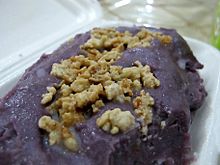- Latik
-
Latík (Tagalog pronunciation: [laˈtɪk] lah-TIK) refers to two different ingredients in Philippine cuisine. In the north it refers to solid coconut curds, the byproducts of coconut oil production, used as garnishing for a variety of desserts. In the Visayan region it refers to a thick syrupy caramelized coconut cream used as a dessert condiment.
Contents
Tagalog Latik
Latík in Luzon is made from coconut milk simmered in a saucepan until it reduces to coconut oil and solids begin to form at the top surface. These solids are left to fry in the coconut oil until golden brown.[1][2]
Latík is commonly used as toppings for a variety of Philippine dishes including maja blanca, sapin-sapin, and ube halaya.(mashed purple yam).[3][4]
They are sometimes mistaken for fried caramelized coconut flesh (another type of garnishing/dessert known as bukayo in Bisaya).[1]
Visayan Latik
Latík in Bisaya literally means 'syrup' (equivalent to the term arnibal in Hiligaynon). It can refer to any type of thick sweetened liquids including jam.[5] In the most common usage, however, latik means a syrupy condiment derived from reducing coconut milk and sugar.[6][7]
It is used much in the same way as syrup, in dishes like kalamay and suman.[8]
See also
- List of Philippine dishes
- Philippine condiments
- Maglalatik (literally "latik maker"), an indigenous Philippine dance
References
- ^ a b "Latik / Fried Coconut Milk Solids". Market Manila. August 5, 2008. http://www.marketmanila.com/archives/latik-fried-coconut-milk-solids. Retrieved July 5, 2011.
- ^ Vanjo Merano (March 25, 2010). "How to Make Latik". Panlasang Pinoy. http://panlasangpinoy.com/2010/03/25/how-to-make-latik/. Retrieved July 5, 2011.
- ^ Reynaldo G. Alejandro & Doreen G. Fernandez (1998). Food of the Philippines. Tuttle Publishing. p. 102. ISBN 9789625932453. http://books.google.com/books?id=m6ZKZ1wHioMC&lpg=PP1&pg=PA102#v=onepage&q&f=false.
- ^ Philippines. Dept. of Education, Culture, and Sports (1989). Duyan ng magiting: the folk culture of the southern Tagalog region. Kalinangan series. Volume 3. IMC. ISBN 9789711012410.
- ^ "latik". Binisaya.com. http://www.binisaya.com/cebuano/latik. Retrieved July 5, 2011.
- ^ "Bisaya translation for "latik"". Bisaya Translator and Cebuano Dictionary. http://cebu.sandayong.com/dictionary.aspx?Cebuano. Retrieved July 5, 2011.
- ^ Philippine quarterly of culture and society (University of San Carlos) 32: 31. 2004.
- ^ "Suman Latik". Lutong Bahay. http://www.lutongbahay.com/index.cfm?pagename=recipe&CategoryID=7&Recipeid=496&members=1. Retrieved July 5, 2011.
Philippine cuisine Individual dishes Desserts - See also: List of Philippine dishes
- Philippine condiments
- Kapampangan cuisine
- List of Philippine restaurant chains
Categories:- Coconuts
- Dessert sauces
- Philippine condiments
Wikimedia Foundation. 2010.


